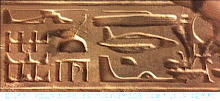Hello Readers,
I thought that today I would talk a little bit about something which I referred to in my last article on the Bohemian Grove that probably sounded a little bit far-fetched (I know, basically everything in this blog falls into that unfortunate category, but some articles seem to do so more so than others- even from my perspective) and so I decided to get to it as quickly as possible. This was on the issue of the Computer Chip and its Kemetic origins, or possible Kemetic origins, you can decide for yourselves. Nothing is new under the Sun, they say... so bear with me.
I thought that today I would talk a little bit about something which I referred to in my last article on the Bohemian Grove that probably sounded a little bit far-fetched (I know, basically everything in this blog falls into that unfortunate category, but some articles seem to do so more so than others- even from my perspective) and so I decided to get to it as quickly as possible. This was on the issue of the Computer Chip and its Kemetic origins, or possible Kemetic origins, you can decide for yourselves. Nothing is new under the Sun, they say... so bear with me.
The model for our modern day computer chip was found to reside in the architectural structure of the Temple of Horus (Haru) at Edfu in modern day Kemet (Egypt, but I will say Kemet from now, y'all follow me, right? Same geographic area, cool?). I will post a link to the original article at the end of this post so you can see and investigate it for yourselves.
 THE INNER SANCTUARY
THE INNER SANCTUARYBasically, the Inner Sanctuary which is located at the eastern end of the temple has a structure akin to the interior of a CPU (Look, you can even see the ridges on the far left side of the diagram and match them with the cpu!!). As you can see in the picture (the images at the top which say, "CPU") the inner sanctuary is surrounded by several chambers, a Vestibule, and the Naos which contains a statue of the Deity Haru, in essence, the most important part of the temple. The chambers surrounding the sanctuary were used for the storing of ritualistic information (perhaps stemming from the kabal or texts prescribing the procedural and spiritual aspects of the ritual and of Haru Itself.) Now, in the CPU there are segments called registers which are used to store information as well.
The next inner chamber is called the Vestible, or, "A course for giving access." In the logic centres of cpu's outer sections of a microprocessor are offered access to the Control Unit.
The Naos is the centre of the temple (wherein you find the statue) and, at least symbolically, controls and works with the dynamics of ritual and tradition, as the Control Unit of a cpu works in conjunction with the microprocessors that surround it. If you look closely, you can see that at the bottom right hand corner of the sanctuary are what look like mini circuit chips.
The next area of the sanctuary is the Offering Hall which was supposed to contain items brought to it from the Second Hypostle Hall. The cpu's cache contains data which is to be brought from an outside source as well-- the Bios Chip.
THE SECOND HYPOSTLE HALL
A Bios chip, if one looks closely, can be seen to appear as a gadget with ridges extending from it which the chip's body are placed on. In the same way, the word, "Hypostle" means "a roof resting on columns or rows of columns."
The function of the bios chip is the booting of a cpu system. It ensures all attachments are in their correct order and transfers control to the bios and loads the program or programs to be used in the RAM.
The function of the Hypostle hall was to prepare the temple for the worship of the Deity and the rituals to be performed thereof. Control of the temple is, for a short time, transferred to this Hall in preparation (so, just before or just as) for the ritual worship. It also brings this tradition of celebration (or, a program) to those in the outer Hypostle Hall who are not yet skilled enough or yet of enough merit or age to be in the inner sanctuary as the ritual is being performed.
HYPOSTLE HALL

This post was supposed to be short, and since the next sections of it are supposed to be shorter, I am going to quote some information directly from the link I am giving you,
"Random Access Memory is a short term memory used to temporarily hold programs to be used by a computer. In the case of the temple, "the computer" is Egyptian Civilization and the "program" is a celebration held in the outer hypostyle hall for those not qualified or required to be in the inner sanctuary or are temporary members."
Clearer than paraphrasing, isn't it? I'm not a computer whiz by any stretch... I am the opposite, in fact. So writing out this terminology is a big bore, but the stuff is damn interesting, so excuse my laziness this one time.
COURTYARD
Last one,
"The open courtyard of this temple has several pillars surrounding it inside of a wall on three sides. A socket which is used to hold a co-processor chip (or Floating Point Unit) on a computer motherboard would be a logical comparison to this area if the "pillars" are interpreted as "holes" and the open area is the hollowed out area of the "socket."
As I've mentioned before, Kemet is a mason state of the previous civilization(s) which were, in the remote past, far more advanced. The pyramids and most of the temples themselves were not built at the order nor at the time of the Pharoahs, but much before. So, the design of this temple and, if you look at the link, the glyph of ancient technology which strangely resembles some of what we have today must have come from an earlier civilization, perhaps Eridu or Lumeria (ask me about it privately if you wish).
In any case, I thought that this information might catch the eyes of people who are more technologically inclined than I am. Cuz I ain't big with computers but the damn thing still stunned me. Click the title of this post, it will bring you to the link as I promised. Check this out and investigate further for your own education. Peace be on all of you,
Karast.

















!["SO[U]L/ Shamush"](http://1.bp.blogspot.com/_D12CqvmBvdo/SXzEh7DvYuI/AAAAAAAAABA/oXOJnFas9Kk/S220/SO(U)L.jpg)




